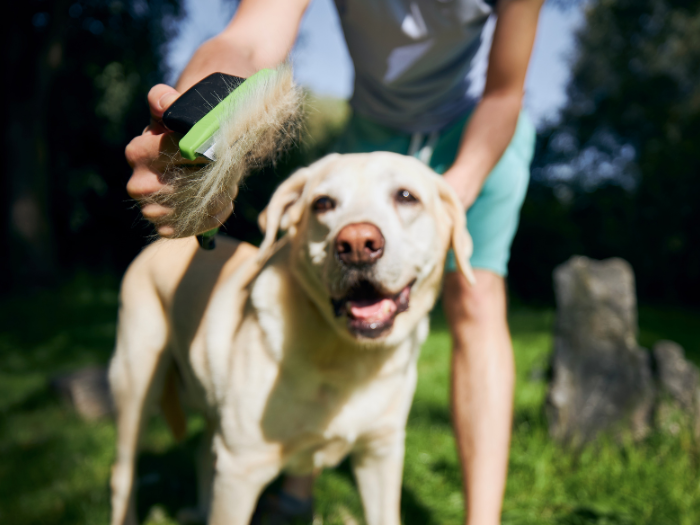
Introduction to Brushing Your Dog’s Coat
Brushing your dog’s coat is an essential grooming task that not only keeps their fur looking beautiful but also promotes overall health and well-being. In this guide, we will delve into the importance of regular brushing and provide you with valuable tips and techniques to make the grooming process enjoyable for both you and your dog.
Benefits of Regular Coat Brushing
Regular coat brushing offers several benefits for your dog:
- Removes Loose Hair: Brushing helps remove loose and dead hair from your dog’s coat, reducing shedding and minimizing the amount of hair around your home.
- Prevents Matting and Tangles: Brushing prevents mats and tangles from forming in your dog’s fur. Mats can be uncomfortable for your dog and may lead to skin irritation if left untreated.
- Stimulates Blood Circulation: Brushing stimulates blood circulation in the skin, promoting a healthier coat and skin condition.
- Bonding Opportunity: Brushing your dog’s coat provides an excellent opportunity for bonding and strengthening the relationship between you and your furry friend.
Understanding Your Dog’s Coat Type
Different dog breeds have varying coat types, each requiring specific care and grooming techniques. Understanding your dog’s coat type is crucial for effective brushing. Here are some common coat types:
- Smooth Coat: Dogs with a smooth coat, such as Dalmatians or Boxers, have short, sleek hair that is relatively easy to maintain with regular brushing.
- Double Coat: Breeds like Golden Retrievers or German Shepherds have a double coat, consisting of a dense, insulating undercoat and a longer, protective topcoat. These dogs require more frequent brushing to prevent matting and remove loose hair.
- Long Coat: Breeds like Shih Tzus or Afghan Hounds have long, flowing hair that requires daily brushing to prevent tangles and maintain a beautiful appearance.
- Wire Coat: Breeds like Wire Fox Terriers or Schnauzers have a wiry and coarse coat that needs regular brushing and occasional hand-stripping to maintain its texture.
Essential Tools for Brushing Your Dog’s Coat
To effectively brush your dog’s coat, you’ll need the following tools:
- Slicker Brush: A slicker brush is ideal for removing tangles and mats in long-haired breeds or dogs with double coats.
- Bristle Brush: Bristle brushes are suitable for dogs with short or smooth coats. They help distribute natural oils and remove loose hair.
- Undercoat Rake: This tool is designed to remove loose hair from the undercoat of double-coated breeds.
- Dematting Comb: If your dog’s coat has mats or tangles, a dematting comb can gently untangle and remove them.
Step-by-Step Guide to Brushing Your Dog’s Coat
Follow these steps for effective brushing:
- Prepare the Environment: Choose a quiet and comfortable area where your dog can relax during the grooming session. Place a non-slip mat or towel on the floor to prevent them from slipping.
- Start with Gentle Petting: Begin the grooming session by gently petting and reassuring your dog. This helps them feel more relaxed and comfortable.
- Use the Right Brush: Select the appropriate brush based on your dog’s coat type. Start brushing from the head and work your way down, following the natural direction of the hair growth.
- Brush in Sections: Divide your dog’s coat into manageable sections and brush each section thoroughly. Be gentle and avoid tugging on any tangles or mats.
- Check for Mats and Tangles: As you brush, check for mats and tangles. Use a dematting comb or your fingers to gently untangle any knots. Avoid using excessive force, as it may cause discomfort or pain.
- Pay Attention to Sensitive Areas: Be extra careful when brushing sensitive areas like the belly, armpits, and ears. Use gentle strokes and ensure your dog is comfortable throughout the process.
- Reward Your Dog: Offer treats and praise throughout the grooming session to reinforce positive behavior and create a positive association with brushing.
Final Tips for Brushing Your Dog’s Coat
To conclude, here are some additional tips for successful coat brushing:
- Establish a Routine: Set a regular grooming schedule to ensure your dog’s coat stays healthy and well-maintained.
- Be Patient: Take your time during brushing sessions, especially if your dog is anxious or unaccustomed to grooming. Patience and gentle handling are key to a positive experience.
- Seek Professional Help if Needed: If you encounter excessive matting or are unsure about the best approach for your dog’s coat, consult a professional groomer or veterinarian for guidance.
- Monitor for Skin Issues: While brushing, keep an eye out for any signs of skin irritation, redness, or abnormalities. If you notice anything concerning, consult your veterinarian.
Remember, regular brushing not only keeps your dog’s coat looking its best but also helps maintain their overall health and well-being. Enjoy the bonding time with your furry companion and keep their coat healthy and beautiful.
